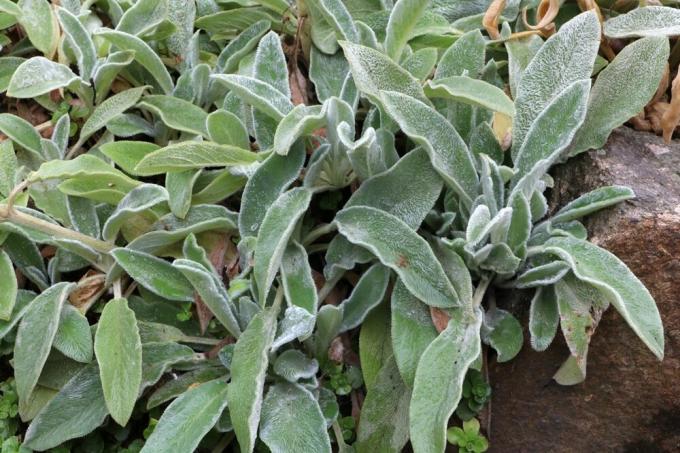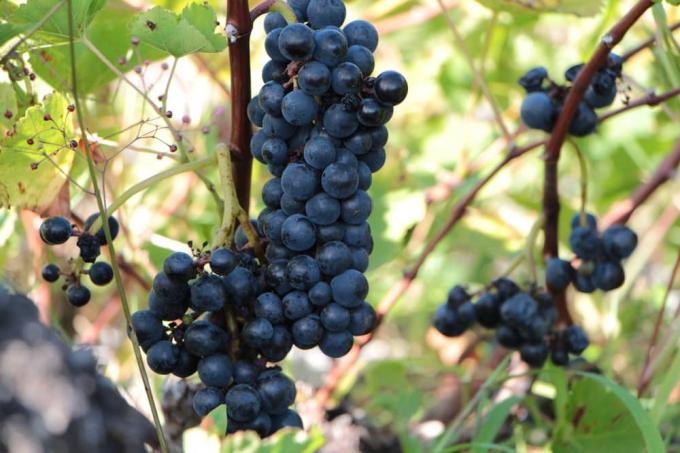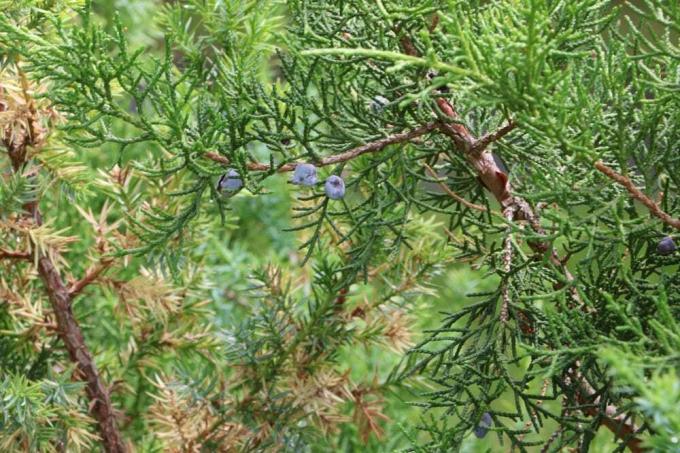

Table of contents
- Location
- soil & plant substrate
- sowing
- Plant
- watering & fertilizing
- Flower, leaves & growth
- Poisonous
- Cut
- hibernate
- sorts
- multiply
- Diseases & Pests
The Wollziest bears the botanical name Stachys byzantina and belongs to the mint family. The plant originally comes from the Near East and is colloquially known as donkey's ear because of its grey, hairy leaves.
Location
Due to its Asian origin, the perennial feels very comfortable in a warm and light-flooded location. The dense hair protects the dog-ear from drying out quickly, which is why it can also grow in exposed locations. Planting in gravel beds and edging flower beds is ideal. The Woll-Ziest is also suitable for planting under borders and perennials. The plant can not only be settled in the garden, but is also well suited for a culture in a bucket or pot.
- Prefers full sun to sunny locations
- Tolerates short periods of shade in partially shaded areas
- But needs at least 3 to 4 hours of blazing sun daily
- Ideal for farm gardens, roof gardens and rock gardens
- Fits perfectly in Mediterranean themed gardens
Tip:
The Wollziest can be used very well as a plant barrier between adjacent plants, as the ground cover suppresses the growth of other plants.
soil & plant substrate
Stachys byzantina is a relatively frugal plant that only makes modest demands on the soil quality. In its homeland, the plant is used to rather dry and poor soil, and too much moisture causes the roots to rot. For this reason, soil that is too moist should already be provided with drainage made of pebbles in the planting hole when planting. If the soil is very rich, it is advisable to add expanded clay, gravel, lava granules, sand or fine grit to thin it out. The better the site and the soil are prepared, the more magnificently the dog-ear thrives.
- Is content with nutrient-poor and sandy soils
- Well-drained soil is ideal
- Pay attention to humic and slightly calcareous properties
- Loosen loamy and compact soils well
- Dry to slightly fresh substrate in the tub
sowing
The Woll-Ziest can be grown from seeds and sowed directly into the bed in spring or autumn. Seeds for sowing are available from specialist retailers. If specimens of the plant are already growing in the garden, the seeds can be harvested after flowering. Wait until the flower candles are completely withered. Then cut them off and carefully remove the seeds. Store the seeds in a dark and dry place until next spring and use them afterwards. Since the dog-ear is a light germinator, the seeds must not be placed too deep in the ground, otherwise they will not germinate.

- Sow directly in the garden bed in April or September
- Alternatively put in seed trays and then put outdoors
- Distribute seeds loosely over the surface of the soil
- Pollinate seeds lightly with soil
- Keep the substrate evenly moist during the germination phase
- Soil should never dry out completely, but should be slightly dry
- Use strong seedlings individually at the desired location
Plant
Stachys byzantina is best planted in the garden during the autumn months. If the soil conditions are not right, appropriate preparation is required in advance. This gives the plant the perfect conditions to feel right at home in its new location. In addition, this also reduces the subsequent maintenance effort. When planting, it is always important to ensure that the Wollziest gets enough distance from the neighboring plants. Since it forms large cushions over time, sufficient space is extremely important.
- Planting possible from March, soil should be frost-free
- The ideal planting time is between September and November
- Plant potted plants just as deep as before in the container
- Maintain a distance of 30 to 40 cm between plants
- Use no more than 5 to 7 plants per square meter
- After planting, press down the surface of the soil well with your hands
- Then water the plant moderately
watering & fertilizing
Thanks to the wool-like hairs on the leaves and flower stalks, the Woolly Ziest can almost always regulate its water balance on its own. Therefore, the usual rainfall in the local latitudes is usually sufficient as a water dispenser. However, premature dehydration can occur during long periods of drought in summer. When the perennial's silvery-grey leaves hang limp, it needs additional watering. Water the surface of the soil directly above the root area and do not wet the leaves. The plant recovers very quickly from drought. Since the Woll-Ziest thrives mainly on poor soil, fertilization is usually not necessary. However, if there is sparse flowering or poor growth, the plant needs supplemental fertilizer information.
- Drought-loving and undemanding plant
- Keep slightly moist during the growing season
- Water only in extreme heat and drought
- Reacts very sensitively to waterlogging and winter moisture
- When keeping buckets, water only after a finger test
- The top layer of substrate should be dry at a depth of 3-4 cm
- Give some compost in case of deficiency symptoms
A notice:
Potted and tub plants also do not need any additional fertilizer, as long as they are repotted in fresh plant substrate every year.
Flower, leaves & growth
The Wollziest is very popular because of its soft leaves, which invite you to stroke it. When touched, the filigree leaves feel like fur. The hairs on the leaves ensure that the plant does not lose too much liquid in the heat. The dog-ear keeps its foliage over the winter months, the leaves only die off in the spring when new shoots emerge. As a perennial, the Woll-Ziest forms dense plant cushions over the years, this factor must be considered when choosing a location. In summer, the long and greyish flower candles and fruits are added. The inflorescences with the numerous individual flowers offer the native insects plenty of pollen and nectar as welcome food.
- Foliage is velvety, tomentose and woolly hairy
- Oval shaped leaves, shimmering in silvery gray color
- Depending on the variety, the leaves are 25 to 50 cm long
- Perennial ground cover, grows creeping
- Growth height varies between 15 and 60 cm
- Flowering time is from June to August
- Forms small and inconspicuous labial flowers
- Depending on the variety, either red, pink, silvery-white or violet
- Ripe nutlets are elongated, hairless and brown in color
Poisonous
The Wollziest has beneficial ingredients and has therefore been one of the medicinal herbs since ancient times. The leaves can be used as a healing pad for skin inflammation. Brewed in tea, the flowers relieve ailments in the stomach and intestines, as well as flatulence and heartburn. However, the herbal plant must not be consumed excessively, otherwise side effects are to be expected.
- With normal consumption not poisonous, but healing
- Overdose leads to mild symptoms of poisoning
- Can be planted easily in the family garden
- There is no danger for children and pets
- Can be used in moderation as feed for rodents
Cut
The evergreen foliage adorns the garden in the cold season until early spring. Therefore, cutting the leaves at the end of the growth phase is not necessary. Only cut back when the hairy leaves lose their attractive appearance. During the summer months, the most beautiful flower stalks and leaves can be cut off to create a decorative vase decoration. If the flower water is changed regularly, the bouquet can retain its natural beauty for many weeks.
- Prune wilted inflorescences in early fall
- Clean the plants after flowering and in spring
- Shorten last year's leaves to the ground at the beginning of spring
- Targeted pruning promotes compact growth
- Curb sprawling growth by cutting off with a spade
hibernate
The Woll-Ziest can withstand extremely low temperatures. However, the plant does not cope so well with permanent winter wetness. In addition, sensitive young plants and specimens in tubs are happy about winter protection.

- Extremely hardy plant, needs no winter protection
- Cover young plants with brushwood during severe frosts
- Lay out some fir fronds over the root area to protect against moisture
- For potted plants, wrap the pot with fleece or jute as a precaution
sorts
Stachys byzantina is available in different varieties, which differ in size as well as in flowering. Since the various varieties also have different growth forms, they can be optimally integrated into the individual garden and terrace design.
Big Ears
- Leaves are particularly reminiscent of donkey ears
- Violet to red flowers in summer
- Stems grow up to 60 cm high
- Medium green leaves with a strongly branched habit
Cotton Ball
- Ground cover with creeping growth
- Pink flowers from July to August
- Woolly flower balls and evergreen leaves
- Stems resemble a cotton plant
- Reaches growth heights of about 40 to 60 cm
Silky fleece
- Blooming variety with violet flowers
- Flowering time from July to August
- Foliage shimmers silvery
Silver Carpet
- Blooms very reluctantly or not at all
- Forms extremely dense foliage
- Is perfect as a ground cover
- Thanks to many runners ideal for rock gardens
multiply
Propagating the Woll-Ziest is just as easy as caring for it. The Stachys byzantina can be bred from seeds and cuttings as well as from offshoots and division. Propagation by division or cuttings is very simple and effective.
Diseases & Pests
The Wollziest is quite resilient and not particularly susceptible to diseases and pests. However, if the plant is too wet or too dark, these factors will adversely affect growth and health. Although snails spurn the plant and do not eat the foliage, they like to congregate in the damp shade under the felty foliage.
- Snails lay their eggs under the leaves
- Check and remove leaf undersides manually
- Apply organic slug pellets as a preventive measure
 garden editorial
garden editorial I write about everything that interests me in my garden.
Learn more about W for juniper

Grapevine, Vitis: care from A-Z | 21 tips for your own grapes
Grapes from your own garden are not just a fresh snack for in between. There are numerous grape varieties around the world. Table vines or table grapes, which were specially bred for fresh consumption, are particularly suitable for cultivation in the home garden.

47 forest plants from A-Z | What plants grow in the forest?
Everyone knows the forest, but what grows there is mostly unknown. Coniferous, mixed and deciduous forests are home to a large number of different plants. Getting to know them is not only a little adventure but an enrichment - also for the menu.

What are wild shoots? How to recognize wild shoots in roses
At first, wild shoots appear quite inconspicuous, but due to their vigorous growth, they soon displace the weaker hybrid tea rose. Therefore, you should remove these shoots as soon as possible. But be careful: Not everything that looks like a wild instinct is actually one. How to detect the unwanted branches.

Rocket juniper, Juniperus scopulorum: care tips
The rocket juniper (Juniperus scopulorum) is also known as columnar juniper and can reach impressive heights. Here we show how it can be cultivated successfully. There are also some care tips that can strengthen growth and the plant.

Keep conifers in the bucket - thuja, cypress and rocket juniper
Evergreen trees and shrubs are an attractive sight all year round because they do not shed their leaves in autumn. Thuja, cypress, and rocket juniper all thrive in pots, provided their needs are considered and they are given the right care.

Cut juniper - as a hedge, bonsai and solitary plant
As a key element in creative garden design, juniper enjoys worldwide popularity. Its frugal cut tolerance contributes significantly to this. This applies to cultivation as an elegant hedge, artistic bonsai and eye-catching specimen. Here you can find out how to professionally trim a juniper so that it retains its individual silhouette for many years.



